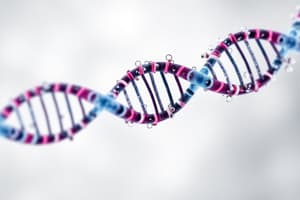Podcast
Questions and Answers
What is the purpose of PCR?
What is the purpose of PCR?
Polymerase chain reaction is a technique used to target specific fragments of DNA and artificially amplify them.
What is the role of primers in PCR?
What is the role of primers in PCR?
Primers are artificial strands of DNA that locate the specific DNA target sequence to be copied.
The DNA fragment to be copied is mixed with free DNA nucleotides and __________ DNA polymerase enzyme.
The DNA fragment to be copied is mixed with free DNA nucleotides and __________ DNA polymerase enzyme.
heat resistant
Describe the process of PCR.
Describe the process of PCR.
What happens during the 'thermal cycling' of PCR?
What happens during the 'thermal cycling' of PCR?
Which of the following are uses of PCR? (Select all that apply)
Which of the following are uses of PCR? (Select all that apply)
Flashcards are hidden until you start studying
Study Notes
Purpose of PCR
- A technique used to target and amplify specific DNA fragments.
- Increases the quantity of desired DNA segments for analysis or research.
Role of Primers in PCR
- Primers are artificial DNA strands designed to match the base sequence of the target DNA fragment.
- They locate the specific DNA sequence needed for amplification, initiating the copying process.
Process of PCR
- The target DNA mixed with free nucleotides and Taq polymerase, a heat-resistant enzyme.
- Two primers are added, complementary to the 3' ends of the DNA fragment.
- The mixture undergoes thermal cycling, which includes three temperature stages: heating to 93°C, cooling to 55°C, and raising to 72°C for amplification.
Thermal Cycling in PCR
- First, heat to 93°C to separate the two DNA strands.
- Cool to 55°C to allow primers to anneal to the single strands of DNA.
- Raise temperature to 72°C, where DNA polymerase adds nucleotides starting from the primers.
- This cycle is repeated numerous times to exponentially amplify the DNA.
Uses of PCR
- DNA fingerprinting: identifying individuals based on biological samples found at crime scenes.
- Genetic testing: examining embryonic cells for genetic diseases during prenatal diagnosis.
- Evolutionary research: utilizing chloroplast DNA for studies in plant evolution.
- Paternity testing: amplifying DNA from a child and potential fathers to confirm parentage.
Studying That Suits You
Use AI to generate personalized quizzes and flashcards to suit your learning preferences.




